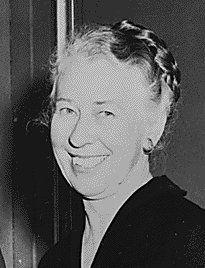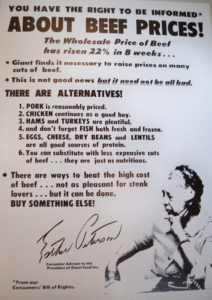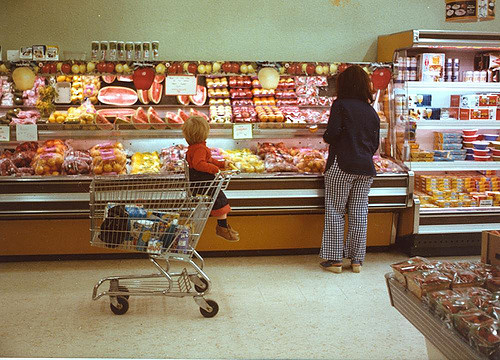By Lawrence Black
Much recent work on consumerism, from Frank Trentmann on things, to Bethany Moreton’s brilliant study of Walmart, through to Robert Miller’s anthropological work, has creatively and productively entangled shopping, politics, everyday life and the public sphere. Building upon this, my article in Historical Research uses the distinctive career of Esther Peterson (1906-97) to explore modern US consumer history. The focus is on the 1960s and 1970s, during which Peterson moved from Lyndon Johnson’s White House to the private-sector supermarket chain Giant and back to Jimmy Carter’s administration.

Peterson was hardly typical individually, but her story does highlight some representative gender aspects to public life and perceptions of the consumer realm. And it is one surprisingly fragmented in the current literature – surprising that is, given the abundance of consumer histories on offer. Peterson does not always or easily fit into the dominant chronologies and framing of those histories. Hers was a career that offers historians a variety of perspectives: federal government, the corporate outlook and consumer activism through to the shopping aisles and the minutiae of labelling. Labelling (price, branding, weight, ingredients, sell-by, packaging, special deals, where and by whom a commodity was made – by unionised labour?) was a sharply contested issue. For Peterson it was about knowledge. She believed access to knowledge and the education to use it wisely and ethically, was the essence of how consumers could flex their market power and enable markets to function fairly. So this is research that addresses broader issues of markets, power, gender and knowledge.
But the article contextualises beyond Peterson’s self to locate continuities and tensions in her wider thinking and practice, that it argues derived from the National Consumers’ League (NCL) that had been formed in 1899 and of which Peterson was President from 1974 to 1976. By the 1970s and indeed since the New Deal, the NCL was a diminished force, but it was a pioneer of consumerism as the exercise of consumer’s agency for the public good and of women’s activism and role in the public sphere, as work by historians like Kathryn Kish Sklar has detailed. The essence of the NCL’s outlook was that, armed with knowledge, consumers could at the very least balance the power of business in the market and even make their own values hegemonic. In short, markets might work fairly – ‘civilising capitalism’ as Landon Storrs’ study of the NCL has it. The practice and ideal of informed and active consumers enabling markets to function more fairly was what Peterson sought to apply in quite different contexts in the government, public policy and at Giant. And it is a practice and aspiration that has resonated fitfully and transnationally in anti-globalization social movements, since Peterson, into the 21st century.

Much as the NCL and Peterson articulated and exposed how business and commercial markets not only reproduced but generated power inequalities, they also felt that consumers and shoppers frequently let progressives down by not exercising their own buying power to redress such imbalances. Progressives felt their analysis was let down by their chosen agents – markets failed consumers, but consumers failed to make markets work. In short, the market-based approach of much consumerism was as subject to the inequalities and imperfections of the market as those commercial institutions, cultures and norms they so damningly critiqued. And the interpretive intervention this article makes is to interrogate the history of this market-based model and approach to consumer action. This was a tension Peterson recurrently encountered and attempted to resolve – in state-level regulation, at Giant and ultimately at the United Nations – and speaks to a more generic tension in progressive, reforming politics: how to improve actors whose current condition you are more-or-less criticizing. It was a tension particularly evident when she became Consumer Advisor for Giant, the Virginia-Maryland-DC supermarket chain, in 1970. An avowed and longstanding consumer activist in the employ of a corporate chain, paradoxical as this may seem, presents a rich empirical case study amidst the ideological contest between the Ralph Nader-led critiques of business and emergent neo-liberalism in the 1970s. Besides explaining how the Cold War meant progressives had to work with market politics, it also makes the point that market politics had a left-liberal-progressive lineage that pre-dated both the Cold War and neo-liberalism.

The article is sourced chiefly from Peterson’s papers at the Radcliffe Institute in Cambridge, Massachusetts and the National Consumers’ League collection in the Library of Congress, but it also draws on (and critiques) the rich literature on market politics (and the even richer literature critiquing them). In terms of my own research this segue into modern US history is a departure, because my previous work has focused on British history. But it picks up themes – of consumerism, shopping, activism, the political culture of the everyday, and how the borders of official and popular politics are constructed and negotiated by actors at the time and historians afterwards – that I have dealt with, such as in a recent piece on the advent of self-service. Shopping and politics were (and are) analogous in analytically and historically productive ways. The most innocuous, everyday activities – in this case, shopping – are loaded with meanings political, cultural and not always evident at the time, a political unconscious if you like. Brexit, by threatening to alter what we see on the shelves, promises to demonstrate this vividly, but it has long been the case.

Lawrence Black teaches history at the University of York and works on the history of 20th century political culture, modern British cultural history and consumer cultures. He has previously written about the history of consumer activism and the advent of self-service in the 20th century as part of a project about shopping in the UK and USA since 1899. Read Lawrence’s article here.
Featured image: Flickr

